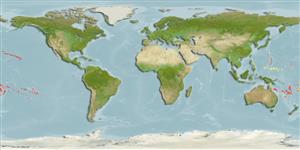>
Eupercaria/misc (Various families in series Eupercaria) >
Emmelichthyidae (Rovers)
Etymology: Emmelichthys: Greek, emmelyes, -es, -es = harmonious + Greek, ichthys = fish + Greek,ops = appearance (Ref. 45335).
Eponymy: Charles Karnella was honoured because he was the first to recognise that specimens from Bermuda thought to be E. [...] (Ref. 128868), visit book page.
More on authors: Heemstra & Randall.
Environment: milieu / climate zone / depth range / distribution range
Ökologie
seewasser benthopelagisch; tiefenbereich 128 - 275 m (Ref. 10394). Subtropical
Eastern Central Pacific: Hawaii and Easter Island.
Size / Gewicht / Alter
Maturity: Lm ? range ? - ? cm
Max length : 22.6 cm SL Männchen/unbestimmt; (Ref. 10394)
Life cycle and mating behavior
Geschlechtsreife | Fortpflanzung | Ablaichen | Eier | Fecundity | Larven
Heemstra, P.C. and J.E. Randall, 1977. A revision of the Emmelichthyidae (Pisces: Perciformes). Aust. J. Mar. Freshwat. Res. 28:361-396. (Ref. 10394)
IUCN Rote Liste Status (Ref. 130435: Version 2024-1)
Bedrohung für Menschen
Harmless
Nutzung durch Menschen
Fischereien: kommerziell
Tools
Zusatzinformationen
Download XML
Internet Quellen
Estimates based on models
Preferred temperature (Ref.
123201): 13.4 - 22.7, mean 18.6 °C (based on 9 cells).
Phylogenetic diversity index (Ref.
82804): PD
50 = 0.5156 [Uniqueness, from 0.5 = low to 2.0 = high].
Bayesian length-weight: a=0.00389 (0.00180 - 0.00842), b=3.12 (2.94 - 3.30), in cm total length, based on all LWR estimates for this body shape (Ref.
93245).
Trophic level (Ref.
69278): 3.4 ±0.4 se; based on size and trophs of closest relatives
Widerstandsfähigkeit (Ref.
120179): hoch, Verdopplung der Population dauert weniger als 15 Monate. (Preliminary K or Fecundity.).
Fishing Vulnerability (Ref.
59153): Low vulnerability (18 of 100).
